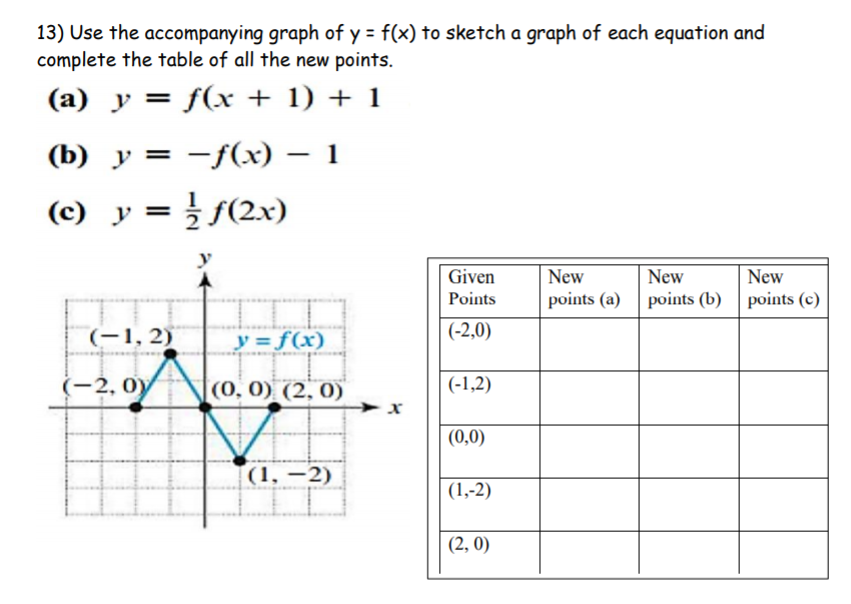13) Use the accompanying graph of y = f(x) to sketch a graph of each equation and complete the table of all the new points. (a) y = f(x + 1) + 1 (b) y = -f(x) – 1 (c) y = } f(2x) y Given New New New Points points (a) points (b) points (c) (-1, 2) y = f(x) (-2,0) (-2, 0y (0, 0) (2, 0) (-1,2) (0,0) (1, –2) (1,-2) (2, 0)
13) Use the accompanying graph of y = f(x) to sketch a graph of each equation and complete the table of all the new points. (a) y = f(x + 1) + 1 (b) y = -f(x) – 1 (c) y = } f(2x) y Given New New New Points points (a) points (b) points (c) (-1, 2) y = f(x) (-2,0) (-2, 0y (0, 0) (2, 0) (-1,2) (0,0) (1, –2) (1,-2) (2, 0)
Algebra & Trigonometry with Analytic Geometry
13th Edition
ISBN:9781133382119
Author:Swokowski
Publisher:Swokowski
Chapter3: Functions And Graphs
Section3.5: Graphs Of Functions
Problem 57E
Related questions
Concept explainers
Transformation of Graphs
The word ‘transformation’ means modification. Transformation of the graph of a function is a process by which we modify or change the original graph and make a new graph.
Exponential Functions
The exponential function is a type of mathematical function which is used in real-world contexts. It helps to find out the exponential decay model or exponential growth model, in mathematical models. In this topic, we will understand descriptive rules, concepts, structures, graphs, interpreter series, work formulas, and examples of functions involving exponents.
Question

Transcribed Image Text:13) Use the accompanying graph of y = f(x) to sketch a graph of each equation and
complete the table of all the new points.
(a) y = f(x + 1) + 1
(b) y = -f(x) – 1
(c) y = } f(2x)
y
Given
New
New
New
Points
points (a) points (b) points (c)
(-1, 2)
y = f(x)
(-2,0)
(-2, 0y
(0, 0) (2, 0)
(-1,2)
(0,0)
(1, –2)
(1,-2)
(2, 0)
Expert Solution
This question has been solved!
Explore an expertly crafted, step-by-step solution for a thorough understanding of key concepts.
This is a popular solution!
Trending now
This is a popular solution!
Step by step
Solved in 4 steps with 3 images

Knowledge Booster
Learn more about
Need a deep-dive on the concept behind this application? Look no further. Learn more about this topic, algebra and related others by exploring similar questions and additional content below.Recommended textbooks for you

Algebra & Trigonometry with Analytic Geometry
Algebra
ISBN:
9781133382119
Author:
Swokowski
Publisher:
Cengage

Algebra & Trigonometry with Analytic Geometry
Algebra
ISBN:
9781133382119
Author:
Swokowski
Publisher:
Cengage